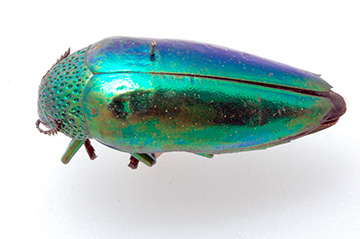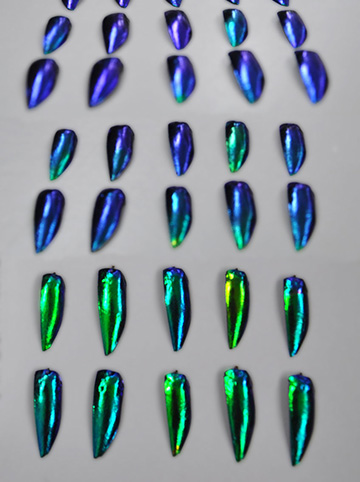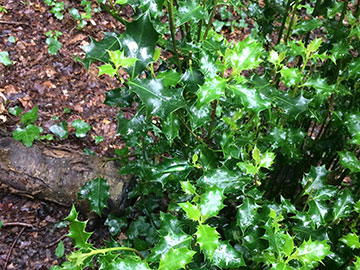
Researchers at the University of Bristol explored whether the eye-catching iridescent colors of Asian jewel beetles—created by interference of light scattered off of nanostructures in the critters’ wings—could, counterintuitively, help to conceal the beetles from potential predators. [Image: Bristol Museums, Galleries and Archives]
Biological iridescence—the striking, shimmering colors that have evolved in many species—often serve to make individual animals more visible, the better to attract mates or warn off predators. But a U.K. research team studying one brilliantly colored beetle species suggests that iridescence can also serve a counterintuitive function: allowing the animals to hide in plain sight (Curr. Biol., doi: 10.1016/j.cub.2019.12.013).
A play of structural color
Iridescence in animals is an archetypal example of structural color, created by micro- or nanostructures in feathers, shells or other tissues that scatter light, giving rise to sparkling, changeable interference patterns. Many explanations for the evolution of these colors in nature rest on their striking visibility. In some cases, for example, the coloration is thought to have serve a sexual function—the tail feathers of the male peacock, strutting his stuff in front of potential mates. In others, the iridescence is thought to constitute aposematism, brilliant coloration that warns potential predators that they’re likely to gag on the prey in question.
The notion that biological iridescence might also serve another, unexpected function—camouflage—isn’t new. In 1906, the artist and naturalist Abbott Thayer suggested that the continual shifting of iridescent colors with direction might allow them to “dissolve” into the similarly shifting, complex natural background. It’s only recently, though, that scientists have started to amass empirical evidence for Thayer’s hypothesis.
Bright-hued beetle

The color of the Asian jewel beetle’s wing changes depending on the directionality of light. [Image: Karin Kjernsmo]
The researchers behind the new work, led by ecologist Karin Kjernsmo at the University of Bristol, U.K., wanted to drill down into the potential role of iridescence as camouflage—and, in particular, to see if it conferred a survival advantage for a species that employed it. They chose one particular iridescent species, the Asian jewel beetle (Sternocera aequisignata), as the test case. As its name implies, the beetle’s wings sport a shiny, shifting and metallic green-blue appearance stemming from structural color.
The Bristol team then used a series of elegantly simple experiments to test the camouflage hypothesis. First, they put together a collection of hundreds of beetle wing cases, including the iridescent wing cases of S. aequisignata and models of wing cases of non-iridescent beetles in a variety of colors, and distributed them in a natural setting amid a variety of plant species. They found, surprisingly, that the iridescent specimens were more likely to survive predation by birds than the non-iridescent variety—even outperforming a leaf-green non-iridescent model that should have blended in with the background colors.
Warning or camouflage?
But did the survival benefit of iridescence actually come from camouflage? Or was it an example of aposematism—a warning to predators that the beetles weren’t good to eat? To find out, the researchers left birds behind, and put humans on the case.
Specifically, the team enlisted human subjects to search through the same natural setting for the beetle wing cases. If the iridescent structural coloration was an example of aposematism, the jewel beetle wing husks should be easier to pick out than the non-iridescent varieties. If iridescence instead conferred concealment, the opposite should be the case.
A jewel beetle wing case becomes particularly difficult to pick out against a leaf background with high specular reflectance. (Yes, it’s there, just over halfway down in the center—enlarge the image for a better view.) [Image: Karin Kjernsmo] [Enlarge image]
Humans, it turned out, had more difficulty picking out the iridescent specimens than the non-iridescent ones. And, tellingly, the difficulty increased for specimens placed on leaves that had a higher level of specular reflection—a glimmer of their own. That clearly suggested that camouflage, not predator warning, was at play.
More than just beetles
“I think that the biggest surprise to us was that when we carried out the same experiment with humans, even they really struggled to spot the iridescent beetles,” Kjernsmo said in a press release accompanying the research. And, she argues, it’s likely that the effect is hardly unique to the small, metallically hued insects in this study.
“We don’t for a minute imagine that the effect is something unique to jewel beetles; indeed, we’d be disappointed if it was,” Kjernsmo said. “If we found that these beetles could be concealed by their colors, it increases the chances that many iridescent species could be using their colors this way.”
To explore that angle, a next step for the team will be to use machine learning to computationally “evolve” the coloration that affords the best camouflage in a given natural environment. The team will then compare the computationally derived colors and patterns with those of real animal species.

